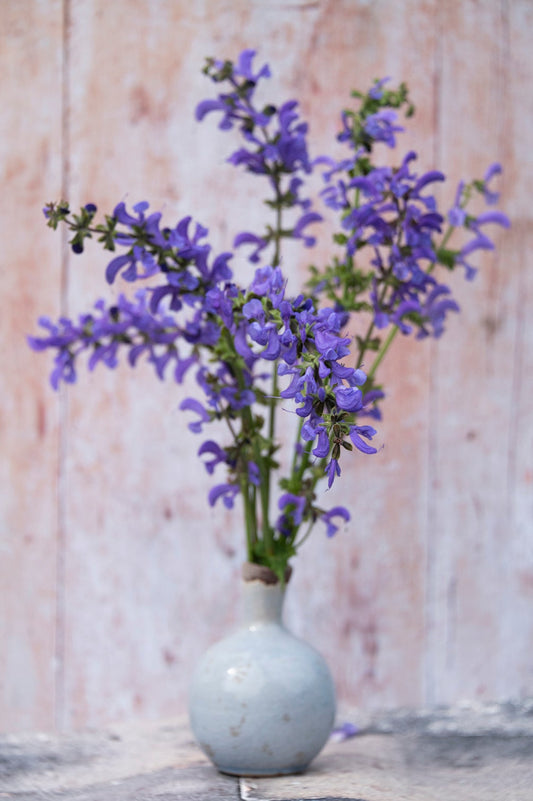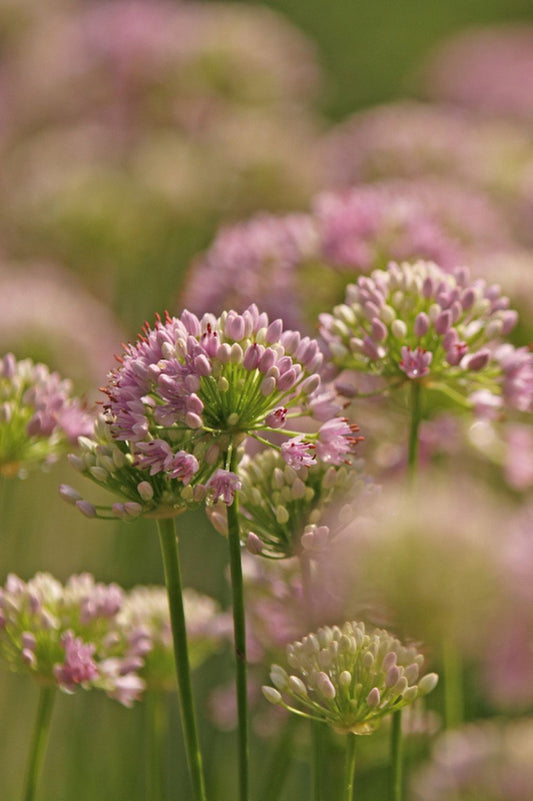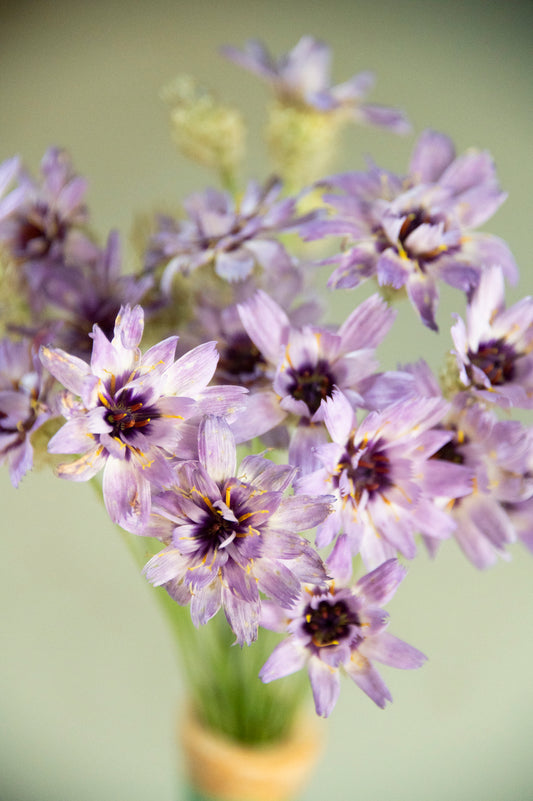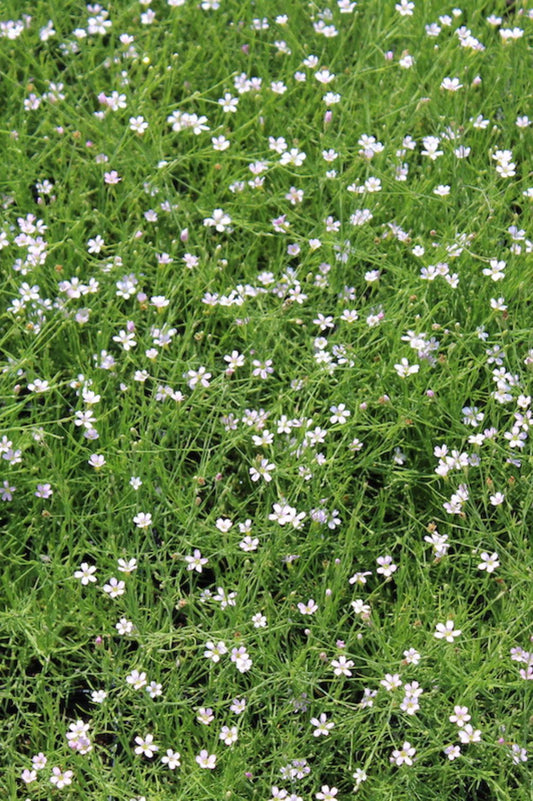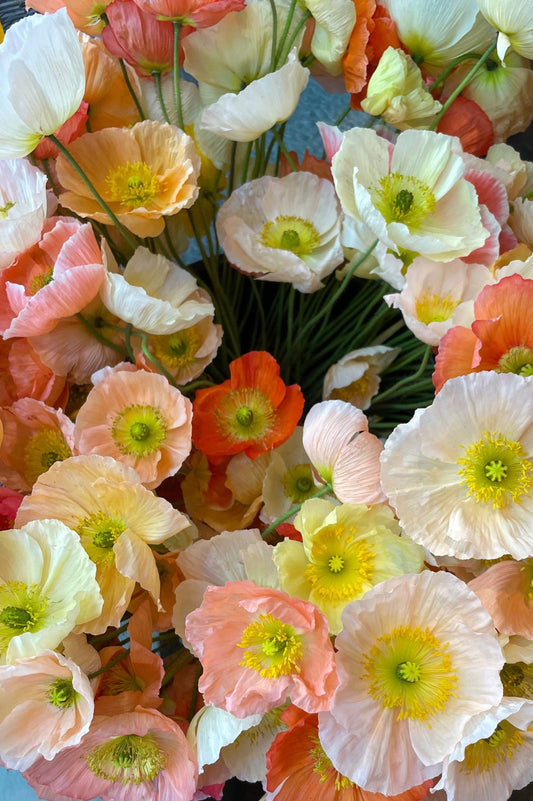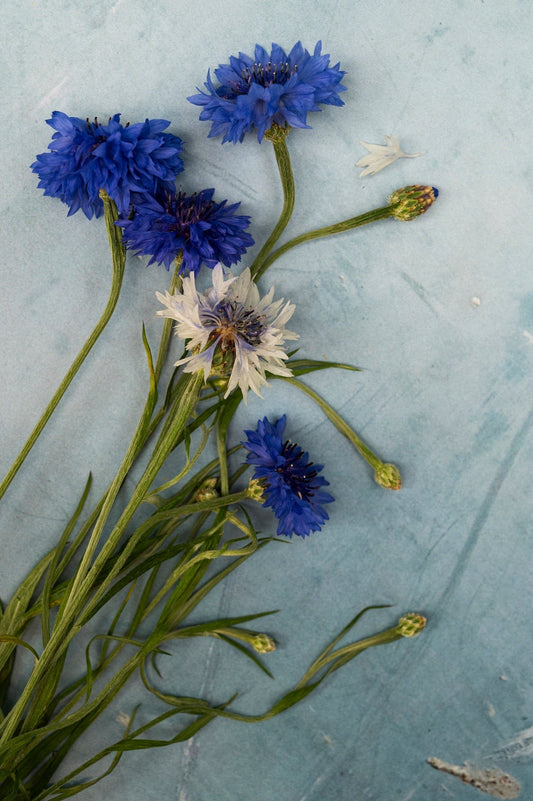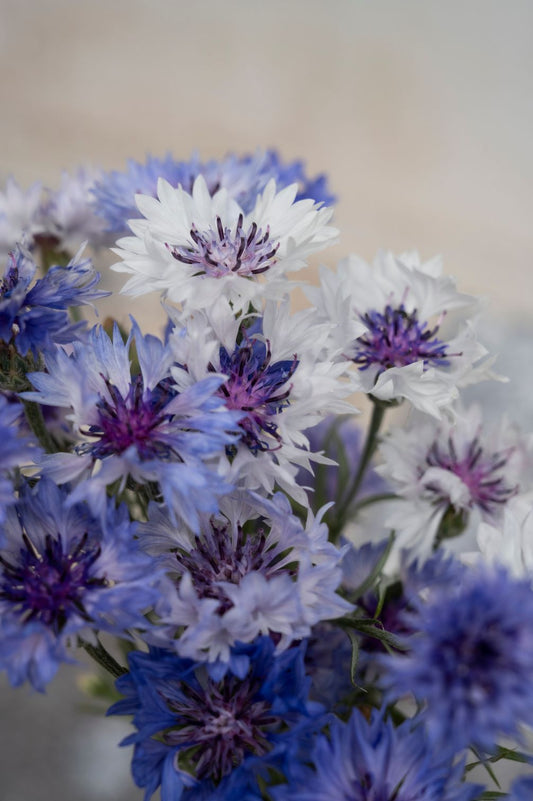22 CLIMATE HEROES IN THE COTTAGE GARDEN – Abundance of flowers with drought-resistant plants
How about enjoying a magical, flower-filled garden without constantly having to worry about watering it? In times of climate change and hot, dry summers, that's certainly an important consideration.

When I'm asked whether I walk through the beds every day in the summer with a watering can or hose, I answer with a simple and honest "No."
I only water pots. The plants in the garden mostly have to take care of themselves, and many can do this without any problems. This is partly because I made sure to select varieties that can also cope with drier periods and because I trained them to develop long, deep roots (you can read how to do this with other valuable tips HERE ).
Here's an overview of 22 plants I have in my garden that tolerate drought very well. And ALL of them are wonderful plants for insects.
1. ROSES

No cottage garden is complete without roses. That's why I'm so glad that roses have deep roots and can easily take care of themselves. The larger the rose, the longer and deeper its roots extend. They can easily reach several meters. One more reason to go for rambling roses! I've never had to water mine.
Insect happiness: Unfilled flowers, yeeeees!
2. LAVENDER

A popular planting partner for roses. However, lavender isn't the ideal companion for roses. Roses need a lot of nutrients, and lavender prefers poor soil. Instead, use catnip or ornamental sage, which I'll mention below. Otherwise, lavender is wonderful and holds up well in the heat. Insect happiness: Great!
3. WOLLZIEST (Stachys byzantina)
So cuddly, so soft (hence its nickname "hare's ear" or "dog's ear"), and incredibly decorative. I love woolly yarrow. Whether as a border, ground cover, or in combination with ornamental sage, catnip, and delicate roses like "Fairy" or "Ballerina." Its flowers aren't the real reason to have it in the garden, but its leaves (which, by the way, stay on in winter!) are all the more so. And it's incredibly undemanding. Insect bliss: And how!

4. Mangrove (Eryngium)
Another great candidate. Its entire appearance in bluish-green tones is enchanting. It, too (it's called "The Seaweed"!) pairs beautifully with woolly yarrow or classic sage. Its spherical, spiky flower heads last a very long time and are ideal for dried arrangements and wreaths. In general, all members of the (noble) thistle family can withstand heat and drought well. Insect happiness: A real hit!

Eryngium magical
5. STEPPE SAGE (Salvia nemorosa)

Big on sage love in the cottage garden.
And why?
Because he is incredibly beautiful.
Because it blooms for a long time.
Because it blooms again after pruning.
Because it goes with basically EVERYTHING.
Because it is white,
pink, blue and purple.
Because that alone offers the most beautiful combination possibilities.
Because it is completely undemanding (you notice,
I'm getting going...)
Because it is pure insect happiness.
6. PURPLE CONSEQUEN (Echinacea purpurea)
Unfortunately, my coneflower always disappears quite quickly (and I haven't been able to figure out why, since it's actually quite undemanding and hardy), but I still like to plant it again and again because it fits beautifully in a cottage garden. And ideally not as a solitary perennial, but rather planted in lush groups. It's charming with Verbena bonariensi, underplanted with Spanish daisies and yarrow; all four delight us with an unusually long bloom period. It's also available in white: Echinacea purpurea "Alba." Insect bliss: YES YES YES!

7. MULKASS (Verbascum)
I don't have the classic variety (yellow), and I won't have it in my garden (how mean am I?!). Thank goodness there are still wonderful non-yellow varieties like the purple Verbascum nigrum, which is also available in white as "Alba." I also love "Sugar Plum" and "Pink Domino." This ancient medicinal plant can reach an impressive height of up to one and a half meters. Insect happiness: 100%

8. Buddleia
I always like it. In pink, purple, and white, the buddleia blooms for an incredibly long time, has an irresistible fragrance, and attracts countless butterflies to the garden. Whether planted as a solitary plant, as a background, or in a smaller version planted in the center of the flowerbed, I find this plant absolutely extraordinary. Insect bliss: Full marks for butterflies and hummingbird hawk-moths.

9. Catnip (Nepeta)
Little effort – big impact. You can't go wrong with this blue-violet flowering perennial. As a ground cover or companion plant, it delights humans and bumblebees (and, in fact, cats too) all summer long with its lush blooms and spicy fragrance, and it's undemanding. It prefers full sun; a little water now and then is sufficient. The flowering period is from May to August. Insect happiness: Absolutely!

10. Sea lavender (Limonium)
A truly uncomplicated and equally undemanding dry-growing hero. The sea lavender blooms tirelessly from June until the first frost in a variety of shades from white to dark purple. Ideal for dried bouquets, it is spurned by snails. Sea lavender, also called statice, thrives just as well in pots. Insect bliss: And how!

If you like sea lavender, you can get it HERE .
11. YARROW (Achillea)
The hardy one. A magical and equally robust companion perennial with fragrant leaves and a very long flowering period from June to October. This native wildflower tolerates dry and hot periods without complaint, is very popular with insects, especially butterflies, and is also well known to us as a medicinal plant. Yarrow is a perfect planting partner because it goes well with pretty much everything. It's funny to observe the size differences depending on the location: normally only around 30–50 cm tall, it can easily reach 80 cm to one meter in nutrient-rich soil. Keep this in mind when planning your flowerbed! Insect happiness: a sure hit.

They come in so many beautiful colors. My favorite blend is " Summer Berries ."
12. WILD MALLOW (Malva sylvestris)
This wonderful creature with its dark pink blossoms is, for me, the epitome of a summer flower. Not just for me—wild bees, bumblebees, and butterflies love it too. The wild mallow is one of the native wild plants; it thrives in partial shade as well as full sun, undemanding, and easy to cultivate. This summer delight reaches a height of approximately 120 cm; flowers, seeds, and leaves are also delicious in salads (or the flowers can be dried as tea!), and it's winter hardy. Insect bliss: You guessed it!

You can find all mallows HERE .
13. Mauritanian Mallow (Malva sylvestris ssp. mauritiana)
And if you want a little more oomph, then try the Mauritanian mallow! Uncomplicated, blooming prolifically, and stunningly colorful. That's how you could sum it up. Insect happiness: ABSOLUTELY!

14. BLUE RULE (Perovskia)
Also blue and also very enchanting. Uncomplicated and easy to care for, the blue rue is a wonderful plant that only needs a little protection during harsh winters. Its enchanting flowers appear from the end of July onwards. It also thrives in rock gardens. And you don't need to fertilize it either. A must-have, right?! Insect bliss: Of course!

15. Stonecrop (Sedum)

Not a crazy bird, but the ultimate all-rounder. Its fleshy leaves store water, which protects it against dry periods. Its magnificent flower clusters are a highlight from blooming to wilting, providing food for many insects well into October. It's also a beautiful sight in the winter garden. Insect bliss: Oh yes!
16. SAGE (Salvia)
Common sage loves dry conditions – just avoid waterlogging! Very undemanding and easy to care for, it appreciates a relatively sheltered spot in the sun or partial shade. In midsummer, from June to August, it adorns its velvety, fragrant, silvery-green foliage with violet-blue flower spikes. It's a kitchen staple, of course; it's perfect for drying and then enjoying as a tea in winter (for sore throats) with a little honey. And in this context: Have you heard of variegated sage? Another great candidate. And the best thing about it? Its incredibly long flowering period....

You can get variegated sage HERE .
17. POPPY (Papaver)
You can sow poppies in late summer ( Cool Flower! ) for the following spring. Or even in early spring. Then you'll have these enchanting, silky flowers in beautiful colors in your flowerbed all summer long. My absolute favorite is Amazing Grey, whose flowers range from blue-gray, purple, and pink. It's always best to sow poppies directly; they don't like being transplanted. Insect luck: This one too!

This is the incredibly romantic " Bridal Silk ".
18. BLUE RATTLE FLOWER
This classic summer flower conjures up images of a summer meadow swaying in the gentle breeze—perhaps because the sedum reminds me of the cornflower. This undemanding, blue-flowering beauty needs plenty of sun and warmth, is unfazed by drought, and also looks great in a vase. The biennial perennial blooms from June to September, grows up to 60 cm tall, and is also an absolute delight for insects.

Do you like it? You can find it HERE .
19. CHAMOMILE
One of the oldest medicinal plants – the taste of chamomile tea is sure to be on everyone's tongue. This extremely adaptable plant thrives in all conditions, but dislikes waterlogging. Insects love this native wild plant; it blooms from June to September and can be harvested when the flower heads have fully opened. Insect bliss: Yep!

20. Rose mallow (Malva alcea)
No garden should be without it! The rose mallow is truly undemanding. A sunny spot and dry, well-drained soil are all it needs to delight us—and the bees—with its simple, pale pink blossoms from June to September. A native endangered wild plant, the rose mallow also contributes to the preservation of biodiversity. Insect bliss: Absolutely!

You can find the rose mallow HERE .
21. SPANISH DAISY (Erigeron karvinskianus)
Admittedly, I only came across the Spanish daisy relatively late in life. Somehow, I always ignored it and didn't really consider it worth noting. A big mistake. It blooms and blooms and blooms and blooms. For months. Nonstop. And it reproduces so wonderfully. In cracks, in walls, in beds, in pots. Light and delicate, like a breath, yet powerful and exuberant in its blooms. Completely undemanding. It's a hardy perennial – as long as it doesn't get too cold – and seeds itself happily. Insect bliss: It does!

You can get this perennial bloomer HERE .
22. Argentine verbena (Verbena bonariensis)
Another highlight! I can't get enough of it in my garden. The verbena (Verbena bonariensis) winds its way delicately through roses and other perennials and blooms tirelessly. It propagates on its own (it does need a bit of protection in harsh winters), but never becomes intrusive, looks beautiful in bouquets, and the butterflies are absolutely thrilled.

Want verbena to enchant your garden? You can get it HERE .
Here are a few more tips for you on what else you can do:
The most important thing of all: Train your plants. By frequent small
If watered too often, they become lazy and form mostly shallow roots. It's better to water infrequently but thoroughly.
You can increase the water-retaining capacity of your soil by incorporating water-retaining granules or special fleece into the soil (if you're interested, there will be a separate blog post about this soon). You'll then need only half as much water. This is also ideal for pots.
Good to know:
A general rule of thumb that is pretty safe to follow: Plants that have fleshy, greasy, rough or hairy leaves are usually good candidates for dry locations.
Also important:
If you've just planted a plant, it will need constant water in the beginning (for the first few weeks). And of course, this also applies when you sow the seeds. Be sure to water it.
Now I have one more request: Please tell me in the comments below which plants you have had good experiences with in drought conditions.
Want to be a climate hero too? I've compiled these twelve varieties for you HERE .

All are great food sources for insects and give us lush flowers with a long blooming period.
You get a complete package with my 12 favorite climate heroes, all perfectly coordinated with each other.
Get your 12 flowers for drought here!
All the best from the Cottage Garden
Your Sarah
Photos: Syl Gervais, Janina Laszlo, @leichter_garten, Alexandra Lehne ( Soulgarden )

